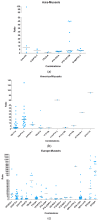Mixtures of Lipophilic Phycotoxins: Exposure Data and Toxicological Assessment
- PMID: 29385038
- PMCID: PMC5852474
- DOI: 10.3390/md16020046
Mixtures of Lipophilic Phycotoxins: Exposure Data and Toxicological Assessment
Abstract
Lipophilic phycotoxins are secondary metabolites produced by phytoplanktonic species. They accumulate in filter-feeding shellfish and can cause human intoxication. Regulatory limits have been set for individual toxins, and the toxicological features are well characterized for some of them. However, phycotoxin contamination is often a co-exposure phenomenon, and toxicological data regarding mixtures effects are very scarce. Moreover, the type and occurrence of phycotoxins can greatly vary from one region to another. This review aims at summarizing the knowledge on (i) multi-toxin occurrence by a comprehensive literature review and (ii) the toxicological assessment of mixture effects. A total of 79 publications was selected for co-exposure evaluation, and 44 of them were suitable for toxin ratio calculations. The main toxin mixtures featured okadaic acid in combination with pectenotoxin-2 or yessotoxin. Only a few toxicity studies dealing with co-exposure were published. In vivo studies did not report particular mixture effects, whereas in vitro studies showed synergistic or antagonistic effects. Based on the combinations that are the most reported, further investigations on mixture effects must be carried out.
Keywords: exposure; mixtures; phycotoxins; toxicological assessment.
Conflict of interest statement
The authors declare no conflict of interest.
Figures











References
-
- Alexander J., Benford D., Boobis A., Ceccatelli S., Cravedi J.-P., Di Domenico A., Doerge D., Dogliotti E., Edler L., Farmer P., et al. Scientific Opinion of the Panel on Contaminants in the Food Chain on a request from the European Commission on Marine Biotoxins in Shellfish—Summary on regulated marine biotoxins. EFSA J. 2009;1306:1–23.
-
- Alexander J., Benford D., Boobis A., Ceccatelli S., Cravedi J.-P., Di Domenico A., Doerge D., Dogliotti E., Edler L., Farmer P., et al. Scientific Opinion on marine biotoxins in shellfish—Cyclic imines (spirolides, gymnodimines, pinnatoxins and pteriatoxins) EFSA J. 2010;8:1628. doi: 10.2903/j.efsa.2010.1628. - DOI
-
- Lee J.-S., Igarashi T., Fraga S., Dahl E., Hovgaard P., Yasumoto T. Determination of diarrhetic shellfish toxins in various dinoflagellate species. J. Appl. Phycol. 1989;1:147–152. doi: 10.1007/BF00003877. - DOI
Publication types
MeSH terms
Substances
LinkOut - more resources
Full Text Sources
Other Literature Sources

